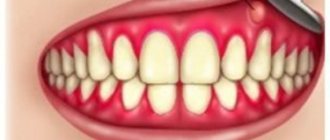Treating gumboil with soda and salt is an effective way to prevent and eliminate unpleasant oral diseases. But before you use it, you need to know the cause of gumboil, what it is, and also be sure to visit an experienced dentist who will first carry out the necessary treatment. After all, soda and salt cannot get rid of already accumulated pus.
Types of flux
This pathology is characterized by several stages of its clinical development. At the first stage, minor pain appears. The second stage is characterized by swelling and redness of the gums in the area of infection.
During the third stage, pus appears, the temperature rises, and the cheek and gum area swell noticeably. At the fourth stage, a person feels a sharp throbbing pain, swelling intensifies, and an extensive inflammatory process may begin. The following types of flux exist:
- Ordinary.
The pathological process occurs without infiltration of the periosteum by pus;
- Fibrous.
With this type of periostitis, inflammation spreads to the periosteum tissue;
- Orthodogenic periostitis.
The disease manifests itself in the form of osteomyelitis, which is a serious complication requiring surgical tooth extraction;
- Albuminous flux.
Chronic pathology, which is characterized by a sluggish course, subfertile temperature and suppuration.
Only a dentist can determine the type of disease and prescribe proper treatment, but before visiting, it is necessary to stop the process.
Features of flux flow and the reasons for its appearance
Flux
Flux (periostitis) occurs when a very strong inflammation process develops. Reasons for its development:
- poor oral care, improper hygiene or lack thereof;
- tooth trauma;
- accumulation of microbes in dental pockets;
- infection of the pulp with advanced caries.
Soft plaque often accumulates on the gingival edges of teeth, which gradually hardens and turns into tartar. It is in such plaque and stones that millions of pathogenic bacteria live, the waste products of which lead to inflammation and ulcers.
Periostitis is accompanied by swelling of the gums and mucous membranes of the cheeks; often the outer side of the face also swells. Depending on where the center of the lesion is located, the eye, neck, and chin areas may swell. The lymph nodes under the jaw often become inflamed, causing pain. If the flux is not eliminated in time, the pus moves into the area of the periosteum, maxillary sinuses and jaw bones.
Self-medication for periostitis is dangerous. Correct treatment can only be prescribed by an experienced dentist, which may vary depending on the characteristics of the disease and its location.
If left untreated, pus accumulates at the top of the tooth root. It is because of this that flux occurs, swelling and pain appear. The infection then spreads to healthy tissue, bone tissue and periosteum. In this case, you cannot do without surgical intervention - removal of pus after an incision and extraction of the affected tooth.
Rinse with flux
Rinse solutions have a regenerating and anti-inflammatory effect on the pathological focus. You can use a soda solution, which reduces pain and inflammation. Rinsing should be done every two hours. Two teaspoons of soda are dissolved in 200 ml of warm water and used throughout the day.
Manganese solution has good therapeutic efficacy. It will reduce swelling by eliminating pathogenic microorganisms. You can use the drug Rotokan, which includes chamomile, yarrow and calendula. To prepare the solution, just add one spoon of Rotokan to warm water. You should rinse your mouth at least 4-5 times a day.
Antiseptics such as Chlorhexedine and Miramistin are also used. They do not need to be dissolved in water. It is enough to irrigate the affected cavity in order to reduce swelling, pain and inflammation. Rinse products similar in their therapeutic effects to Miramistin and Chlorhexidine also include Furacilin, which is sold in tablets. A couple of tablets are enough to prepare 200 ml of solution for treating the oral cavity.
Tooth flux - what to do?
The most popular search on the Internet: “how to get rid of gumboil”, “how to remove gumboil from a tooth”, “removing gumboil at home”. If you detect even the slightest signs of flux, we recommend seeking help from a doctor. Flux on the cheek is a pathological process that requires mandatory treatment, which will avoid serious complications, including conditions that threaten the patient’s life.
If signs of flux suddenly appear, before consulting a doctor, you can perform procedures that will help reduce swelling. But they should be considered as a temporary remedy to alleviate the patient’s condition.
How to rinse with flux? The following solutions can be used to relieve pain:
- Alcohol tincture of calendula. A teaspoon of the product is mixed in a glass of water. The resulting solution is used to rinse the mouth.
- Infusion of green tea and sage. To do this, use a teaspoon of sage and green tea in a glass of water. The herb is poured with boiling water and infused for 20-30 minutes. You should regularly rinse your mouth with the resulting solution.
- Mint and lemon balm leaves. The herb is poured with boiling water and left for 3-4 hours. The resulting infusion is used to rinse the mouth.
Compresses and lotions for periostitis
Compresses and lotions have a local anti-inflammatory and disinfecting effect, they destroy pathogenic microbes and will help get rid of swelling on the mucous membrane. You can use the drug Dimexide, which is diluted with water until a concentration of 20-30% is reached. The compress is applied to the area of inflammation and left for about an hour.
Soda lotions also help a lot. Baking soda is diluted in a volume of two teaspoons in 200 ml of water. You can moisten a cotton pad or several layers of gauze with the solution and then apply the lotion to the affected area of the gum.
Good therapeutic effectiveness is also observed when using salt compresses. It is enough to dissolve a couple of teaspoons in 100 ml of warm water. A gauze swab soaked in the solution should be applied to the inflamed area and held between the gum and cheek for at least half an hour.
FAQ:
How to rinse the flux to make it break out?
As we wrote above, any procedures cannot replace consultation and treatment in a dental clinic. Before visiting a doctor, in order to alleviate the condition and reduce swelling (edema), you can rinse your mouth with various antiseptic and antimicrobial agents, for example, chlorhexidine. Additionally, you can use sodium saline solution, sage decoction, and calendula tincture.
The flux has burst - what to do?
If the flux has burst, the time before visiting the doctor can be used to carry out simple procedures on your own. First of all, you should rinse your mouth with clean water at room temperature. You can do this using a soda solution - to do this, you need to dissolve a teaspoon of soda in a glass of warm clean water. It is advisable not to eat before being examined by a doctor.
What to do to prevent flux?
The best prevention of flux is regular hygiene procedures in the oral cavity and timely treatment of foci of chronic infection.
Do not forget that gumboil may not go away on its own, turning into a chronic disease, and given that it poses a serious danger to human health, we recommend that you do not hesitate to contact a dental clinic. Only here is reliable diagnosis and effective treatment possible. Be healthy!
Anti-inflammatory drugs and antibiotics
The use of antibiotics helps relieve pain and stop acute inflammation. You can use antibiotics such as Trichopolum, Lincomycin, Ciprofloxacin, Flemoxin, Biseptol, Amoxiclav, Tsiprolet. Antibacterial drugs should not be used for more than five days to avoid microbial resistance in the body.
To reduce swelling and redness, you can additionally take Diazolin, Nimesil or Diclofenac, which have a local anti-inflammatory and decongestant effect.
Antibiotics
The use of antibiotics is an important point in successful flux therapy. At an early stage, these medications can stop the spread of infection and prevent the appearance of an abscess. At later stages, when a purulent focus has already formed, antibacterial drugs are prescribed after opening it to prevent complications and speedy recovery.
Antibiotics for gumboils should not be taken independently. Only a dentist can give a recommendation which drug should be taken and in what dosage. This will depend on the patient’s age and weight, his condition and the presence of drug intolerance.
The most commonly used antibacterial agents for flux:
- Lincomycin
- Amoxicillin
- Tsiprolet
- Amoxiclav
- Doxycycline
- Ciprofloxacin
- Trichopolum
- Flemoxin solutab
- Biseptol
- Levomycetin
Antibacterial drugs should not be used for less than 5-7 days or stopped after the condition improves. This can cause drug resistance in the microorganism that caused the flux, and lead to loss of effectiveness of the drug if the disease reoccurs.
Gels and ointments
Ointments are used for topical application. In particular, this is Vishnevsky’s ointment, which stops the development of the purulent process. The birch tar included in its composition increases blood circulation in tissues and accelerates their natural regeneration.
Among modern gels, it is recommended to use the drug Metrogyl Denta, which contains antibacterial components in the form of Chlorhexidine and Metronidazole.
This article is for informational purposes only, please consult your doctor for details! Ask your doctor about contraindications and side effects.
Flux - treatment in a dental clinic
The choice of treatment method for flux depends on the type of periostitis, its severity, and the individual characteristics of the body. In the acute form, the nerve is removed, the wound is opened and cleaned, treated with antiseptics, and antibiotics are prescribed.
To defeat purulent flux in an adult, they resort to a more comprehensive treatment program. In this case, additional procedures may be prescribed, as well as complex antibiotic therapy.
Regardless of the type of periostitis (excluding the chronic form of flux), a mandatory step is a course of antibiotics, which is selected individually. As a rule, with the right course of treatment, the flux goes away within 7-10 days (stable positive dynamics of recovery are recorded on days 3-5). In the chronic course of the disease, the tooth after gumboil is usually removed.
Let us remind you once again that by refusing professional help, you risk your health. Without the participation of a doctor, there is a high probability of the formation of a gingival fistula, the penetration of pus into nearby tissues, which causes the development of phlegmon.
What EliteDental M dentists recommend
It happens that the patient does not have the opportunity to see a doctor immediately (harmful management at work, urgent matters or meetings, no one to leave the child with, etc.). Therefore, our dentists have put together a number of tips for you to slow down the development of gumboil and relieve primary swelling.
The tips have been tested in practice by our patients and help well as first aid. They work great to prevent the appearance of flux. And yet, you shouldn’t completely forget about visiting the dentist. How to deal with the appearance of flux yourself:
- Rinsing. The most effective is the old-fashioned method of rinsing your mouth with a solution of soda and salt. This will help reduce the number of germs in your mouth, but will not get rid of gumboil. Rinsing has only an external effect. No solution will reach the infection inside the gum.
- Painkillers. When the situation is not reversible, severe pain occurs (gums, headache). You can take your usual painkillers.
- Do not self-medicate. Treatment with folk remedies either helps or worsens the situation. In practice, there have been cases where self-medication led to emergency surgery. Don't guess whether it will pass this time or not. It’s better to make an appointment with your dentist once again. This will save your teeth, money and nerve cells.
Be attentive to your health! Make an appointment with the dentist by leaving a request by mail or by phone +7 (988) 544-63-54 (Zhdanova St. 3), (Mironov St. 6).
Flux diagnostics
The patient can recognize the first manifestations of flux himself. He will feel the characteristic symptoms described above. Regardless of the stage of the disease, you need to see a dentist for an appointment. The doctor will conduct an initial examination of the gums. If necessary, he will prescribe x-rays and tests to determine the stage of inflammation and possible complications. The dentist then selects an individual treatment.
Early contact with the dentist will help to quickly cure gumboil and avoid possible complications.











